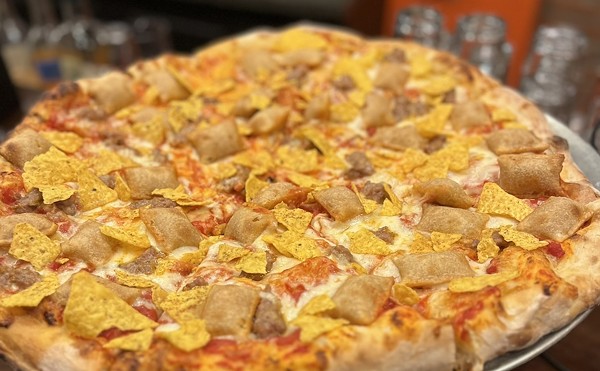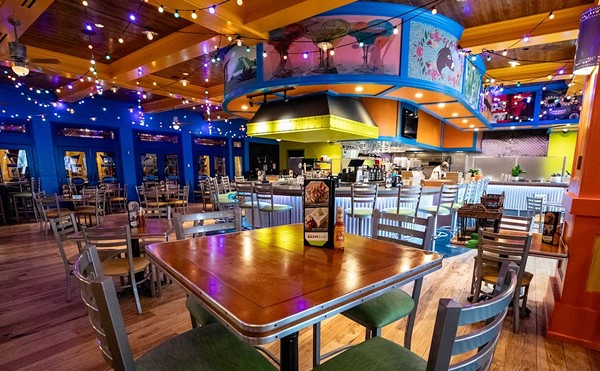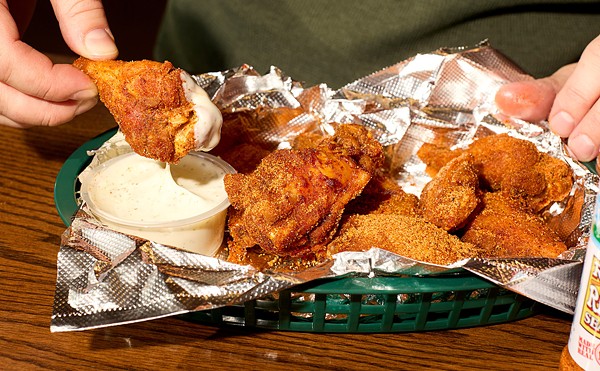Perhaps this little fantasy should be titled "Brownfield of Dreams." The names of the principal characters -- M. McGuire and K. Warner -- are deliciously ironic in the sports-immortals context. Only if the restaurant were located on an obscure corner of Iowa Street, instead of at 39th and Chouteau, could the analogy get much tighter.
McGuire, the owner, and his cousin Warner, the chef, are the frontroom and backroom guys, respectively, at King Louie's, now passing its seventh year at this unlikely location, reasonably close to the St. Louis University medical complex but not really near anything at all. For many years, the location housed Billy Goat Hill, a popular place for burgers, wings and beer at lunch and burgers, wings, beer and local and regional bands in the evenings. In its original incarnation, before Prohibition, the space was a hospitality room for the Otto F. Stifel Union Brewery, which was found at Gravois and Michigan (again, not Iowa, but just six blocks away).
Earlier this year, McGuire (the "M" is for Matt) decided to swing for the fences by doubling the capacity of the dining room to about 150, the latest step in a strategy that's included the slow transformation of the menu into an eclectic but heavily Asian-accented selection of innovative, thoughtful dishes and the building of a cellar to house an extensive wine collection, one that has since snagged a Wine Spectator commendation.
The quick summary? If you haven't yet found the way to 39th and Chouteau, you've been missing out on one of the best restaurants in St. Louis.
Chef Warner (the "K" is for Kirk) isn't afraid to take chances, incorporating challenging flavor accents such as an eye-popping Thai chile sauce as one of the sauces for the nightly selection of fresh oysters, and even some complete surprises (who'd have thought that rhubarb would be an ideal sweet-tangy complement to grouper?).
Those oysters -- from the West Coast, as are more and more on local menus -- were the starting point for one of our meals, and they're also available for slurping at the bar, although at about a buck apiece, it's not like the good old days of $3-a-dozen Gulf oysters in season at Nantucket Cove. The choices on our visit were Evening Cove from British Columbia and Chef's Creek from Washington state, the one a deceptively large and plump oyster owing to a deep recess in its shell and the other smaller and flatter but with a more complicated flavor, sort of like what a sea breeze might taste like. In addition to the fire of the chile sauce, another dipping choice was the gentler tang of a rice-wine mignonette.
A slightly sweeter but still fiery Asian spiciness was found in the "firecracker" sauce on another of the appetizers, potstickers, about twice as big as the standard Chinese-restaurant variety, additionally altered from the norm by the use of turkey in the filling. Belgium was the apparent inspiration for another of the appetizers, pommes frites (French fries), served in the Belgian style with an accompanying mayolike dip (dolled up here into "white pepper-truffle crème) and also à la Chateau Blanc -- cheese fries, that is -- with the addition of melted slivers of Parmesan.
The best appetizer during our two visits, though, was an ode to spring that combined poached Michigan asparagus, chilled bay scallops in a lemon-and-dill aioli and radishes from Bellew's Creek Farm, a local organic grower. The scallops themselves -- at least a couple dozen, slightly bigger than minimarshmallows -- could have stood alone with the delicate garlic, lemon and dill cream lightly dressing them, but the half-dozen stalks of asparagus and the wafers of radish (along with a spidery sprig of dill) added not just further diversity of flavor but a marvelous visual display of red, snow white and various greens. Warner, it turns out, attended the University of Southern California film school, and I'm guessing he got an A in composition.
The flair for presentation continued to be in evidence with the entrées -- for example, jumbo shrimp, truly deserving of that name, basted in an orange-brown ginger sauce, with two of the six intertwined atop a half-globe of jasmine rice and the rest interspersed among sautéed baby bok choy and cubes of roasted sweet potato, with an otherworldly disc of flash-fried lotus root alongside. Or the grouper, "gold potato crusted" by virtue of a beret of thin, round slices of potato, with a layer of wilted greens underneath, followed by a layer of a barleylike toasted grain called farro and, finally, the almost giggle-inducing combination of sweetness and acid tartness from the bottom layer of a savory rhubarb ragout.
The Asian influence -- which McGuire lovingly attributes in large part to "Mr. Kim," a Vietnamese immigrant who worked in the restaurant until his death last year -- reappeared in multiple forms in the preparation of a fish called ono, instant karma if there ever was such a thing. The full-bodied, meaty fish, also known by the amusing name of wahoo, was marinated with a gingery spice native to Southeast Asia called galangal and served over a spice-softening base of shredded cucumber, with a fresh selection of mixed vegetables and crispy, almost sweet cakes of special rice on the side.
Even a basic strip steak transcended the ordinary with sides of flash-fried onion strips and a variation on potatoes au gratin using Fontina cheese.
Desserts, made on the premises, were also both elaborate and gorgeous -- a carrot genoise, for example, basically a carrot cake lacking almost all of the expected density, served with candied roasted almonds, a miniature scoop of vanilla ice cream and a subtly lemon crème anglaise with a level of delicateness equal to that of the cake. The mango tartlet was a burst of bright colors -- the orange of razor-thin slices of the main ingredient, red from slivered strawberries and a gaudy lipstick hue from a scoop of raspberry sorbet, flanking a triangle of the tart itself.
As you'd expect from a Wine Spectator-commended list, the wine selection is extensive, numbering about 200 bottles and including everything from Prosecco and a $250 bottle of vintage Veuve Clicquot La Grande Dame among the sparkling wines to a wide selection of "extraordinarily refreshing whites from hither and yon" to 10 magnums each of "big reds" and half-bottle (and smaller) sizes. (As a point of reference, McGuire was overheard noting that the cellar was "light on Alsatians." We should all have such crosses to bear.) And if you'd rather bring your own, the wine list repeatedly touts the existence of a $15 corkage fee, a practice that's more common than you might think in local restaurants but is rarely stated publicly.
In general (a botched dessert order notwithstanding), the service was excellent, with obvious effort having been taken to train the staff on the nuances of the oysters, the ingredients in many of the preparations and even the basic definition of unusual items such as galangal and ono.
Before you go dashing off to find this place (most easily accessed from the west by taking the Vandeventer/Chouteau exit of Highway 40 eastbound and staying to the right until the ramp feeds into Chouteau at the stoplight, then turning left and going about two blocks), you should be prepared for the atmosphere. It's not shabby, but it is a former saloon, and it's a little dim. Some of the booths, even with the addition of blue velvet throw pillows where the bench meets the wall, are somewhat spartan. It may not be the kind of place in which you'd expect to find $20-plus entrees, but you'll get used to it.
The St. Louis area may or may not get a World Series and a Super Bowl in the next few months, but it certainly has a wonderful, newly expanded venue for championship cooking. Be sure to seek it out.





